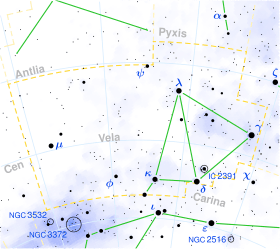Omicron Velorum
Omicron Velorum (ο Vel, ο Velorum) is a star in the constellation Vela. It is the brightest member of the loose naked eye open cluster IC 2391, also known as the ο Velorum Cluster.
 | |
| Observation data Epoch J2000.0 Equinox J2000.0 | |
|---|---|
| Constellation | Vela |
| Right ascension | 08h 40m 17.58553s[1] |
| Declination | –52° 55′ 18.8002″[1] |
| Apparent magnitude (V) | +3.60[2] (3.57 - 3.63[3]) |
| Characteristics | |
| Spectral type | B3 IV[4] |
| U−B color index | –0.62[2] |
| B−V color index | –0.18[2] |
| Variable type | SPB[3] |
| Astrometry | |
| Radial velocity (Rv) | +16.1±0.7[5] km/s |
| Proper motion (μ) | RA: –24.42[1] mas/yr Dec.: +34.44[1] mas/yr |
| Parallax (π) | 6.61 ± 0.35[1] mas |
| Distance | 490 ± 30 ly (151 ± 8 pc) |
| Absolute magnitude (MV) | −2.48[6] |
| Details | |
| Mass | 5.5 ± 0.4[4] M☉ |
| Radius | 4.3 ± 0.7[4] R☉ |
| Luminosity | 1,000[4] L☉ |
| Surface gravity (log g) | 3.91 ± 0.20[4] cgs |
| Temperature | 16,200 ± 700[4] K |
| Rotational velocity (v sin i) | 9 ± 5[4] km/s |
| Other designations | |
| Database references | |
| SIMBAD | data |
Omicron Velorum is a blue-white B-type subgiant with a mean apparent magnitude of +3.60. It is approximately 495 light years from Earth. A slowly pulsating B star, it ranges between magnitudes 3.57 and 3.63 over 2.8 days.[3]
The correct Bayer designation for ο Velorum has been debated. Lacaille assigned one Greek letter sequence for the bright stars of Argo Navis. These Lacaille designations are now shared across the three modern constellations of Carina, Puppis, and Vela so that the same Greek letter is not usually found in more than one of the three.[7][8] However, ο (omicron) is commonly used for stars in both Vela and Puppis. Some authors contend that Lacaille actually assigned a Latin lower case 'o' to this star,[9] while others suggest that ο Puppis should actually be a lower case 'o'.[10] In the Coelum Australe Stelliferum itself, this star is labelled ο (omicron) Argus (du Navire in the French edition), while ο Puppis is labelled (Latin) o Argus in puppi (Pouppe du Navire in the French edition).[11][12]
References
- van Leeuwen, F. (November 2007), "Validation of the new Hipparcos reduction", Astronomy and Astrophysics, 474 (2): 653–664, arXiv:0708.1752, Bibcode:2007A&A...474..653V, doi:10.1051/0004-6361:20078357
- Johnson, H. L.; et al. (1966), "UBVRIJKL photometry of the bright stars", Communications of the Lunar and Planetary Laboratory, 4 (99): 99, Bibcode:1966CoLPL...4...99J
- Samus, N. N.; Durlevich, O. V.; et al. (2009). "VizieR Online Data Catalog: General Catalogue of Variable Stars (Samus+ 2007-2013)". VizieR On-line Data Catalog: B/gcvs. Originally Published in: 2009yCat....102025S. 1. Bibcode:2009yCat....102025S.
- Hubrig, S.; et al. (January 2009), "New magnetic field measurements of beta Cephei stars and Slowly Pulsating B stars", Astronomische Nachrichten, 330 (4): 317, arXiv:0902.1314, Bibcode:2009AN....330..317H, doi:10.1002/asna.200811187
- Gontcharov, G. A. (November 2006), "Pulkovo Compilation of Radial Velocities for 35495 Hipparcos stars in a common system", Astronomy Letters, 32 (11): 759–771, arXiv:1606.08053, Bibcode:2006AstL...32..759G, doi:10.1134/S1063773706110065.
- Anderson, E.; Francis, Ch. (2012), "XHIP: An extended hipparcos compilation", Astronomy Letters, 38 (5): 331, arXiv:1108.4971, Bibcode:2012AstL...38..331A, doi:10.1134/S1063773712050015.
- Coelum australe stelliferum ... H L Guerin & L F Delatour. 1763. pp. 7–.
- Kostjuk, N. D. (2004). "VizieR Online Data Catalog: HD-DM-GC-HR-HIP-Bayer-Flamsteed Cross Index (Kostjuk, 2002)". VizieR On-line Data Catalog: IV/27A. Originally Published in: Institute of Astronomy of Russian Academy of Sciences (2002). 4027. Bibcode:2004yCat.4027....0K.
- Hoffleit, D.; Jaschek, C. (1982). "The Bright Star Catalogue". The Bright Star Catalogue. Bibcode:1982bsc..book.....H.
- Wagman, Morton (2003). Lost Stars. McDonald and Woodward. p. 259. ISBN 0-939923-78-5.
- La Caille, Nicolas Louis de. "Coelum Australe Stelliferum". Retrieved 2017-07-21.
- La Caille, Nicolas Louis de. "Coelum Australe Stelliferum". Retrieved 2017-07-21.